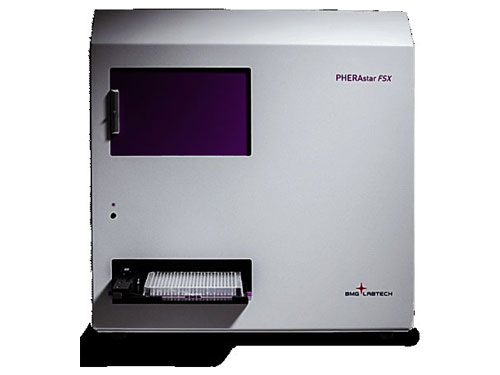The PHERAstar® FSX is our most sensitive multi-mode reader for high-throughput screening, combining this sensitivity with fast read times. Thanks to the unique Optic Module system, Simultaneous Dual Emission, UV/vis spectrometer, and dedicated AlphaScreen® and TRF lasers, the PHERAstar FSX will perform your assay with ease and speed, even in 3456-well microplates.
Product Details
No longer worry about installing filters and dichroics: the PHERAstar FSX comes with easy-to-handle, assay-optimized Optic Modules which contain all application-specific filters, mirrors, dichroics and/or polarizers, and are automatically recognized by the plate reader. In addition, the PHERAstar FSX is equipped with four matched and assay-optimized photomultiplier tubes (PMTs) which are automatically selected for the relevant detection mode. You can also measure assays with two emission wavelengths at the same time thanks to the Simultaneous Dual Emission.
For HTS automation purposes, the PHERAstar FSX offers improved robotic integration capabilities and multi-user control.
Features
- The most sensitive reader in fluorescence intensity and polarization
- The only plate reader with 5 assay-dedicated detectors
- Simultaneous Dual Emission, including for Alpha Technology
- 9 decades luminescence dynamic range
- Dedicated AlphaScreen®/AlphaLISA®/AlphaPlex™ laser
New generation TRF-laser - Top and bottom focal height adjustment
- High-precision injectors with simultaneous reagent injection and detection
- High-speed absorbance measurements

Microplate reader technologies
Excitation lasers significantly improve performance and lower limits of detection, since they yield higher excitation energy at a specific wavelength when compared to xenon lamps. Both the CLARIOstar and the PHERAstar FSX can be equipped with a laser dedicated to Alpha Technology (AlphaScreen® , AlphaLISA® and AlphaPlexTM ) detection. This dedicated laser outperforms any xenon-based light source by specifically exciting donors at 680 nm.
Fluorescent and luminescent detection of adherent cells substantially profits from measurements performed from the bottom of the well. The PHERAstar FSX and the CLARIOstar have a free air optical path to the bottom of the microplate, improving sensitivity and eliminating the need for fiber optics or light guides.
Unlike conventional microplate readers, all BMG LABTECH readers require no displacement or installation of any additional hardware when switching between top and bottom reading modes.

Many of today's most popular assays such as enzyme kinetics, calcium flux, and dual luciferase require the ability to monitor a signal during and after the addition of a reagent.
All BMG LABTECH readers, with the exception of the SPECTROstar Nano , can be equipped with up to two built-in reagent injectors. Injectors enable reagent delivery to any plate format from 6 to 384 wells.

BMG LABTECH was the first and is the only microplate reader manufacturer to equip its instruments with a UV/vis spectrometer for absorbance measurements. Similar to a monochromator, but much faster, the spectrometer will capture full-absorbance spectra from 220 to 1000 nm at a resolution of 1 nm in less than one second/well. Alternatively, up to eight discrete wavelengths can be collected at the same time.

Simultaneous Dual Emission (SDE) detection allows the measurement of two emitted wavelengths at the same time. It reduces plate read times and corrects for any signal variation due to differences in well volumes, concentrations, or fluctuations in excitation energy. SDE is the ideal tool for double-emission assays such as FRET, TR-FRET, fluorescence polarization and BRET, since the sample only has to be read once.

Automation is a key feature in high-throughput screening. Several BMG LABTECH microplate readers have been successfully integrated into various robotic systems. Since all instruments have the same x-y dimensions and plate out/in position, once automation has been designed for one BMG LABTECH reader, the solution will work for all. All plate readers can be controlled through ActiveX or DDE interfaces. Moreover, the ASCII data output is the most versatile in the industry and works with most LIMS and automation platforms.
A unique feature of the PHERAstar FSX , Decay Curve Monitoring provides an indispensable tool for assay troubleshooting and performance fine-tuning for TRF, TR-FRET and AlphaScreen ® assays. Thanks to special detectors with direct photon measurement system, fluorophore decay curves can be collected for one or two wavelengths with a user-selectable resolution of down to 2 µs.

Absorbance measurements such as DNA quantification or protein determination detected in a microplate reader are frequently compared and/or normalized to results from a 1 cm path length cuvette. All BMG LABTECH microplate readers have the ability to perform a 1 cm path length correction thanks to an internal fitting algorithm. Using this correction, data normalization to 1 cm path is given with only one mouse click.

Shaking and incubation allow users to mix the well content and easily run measurements at elevated temperatures. The incubator controls the air temperature in the measurement chamber from room temperature up to 45 °C or 65 °C. BMG LABTECH microplate readers are equipped with orbital, double-orbital or linear shaking with definable intensity, duration and direction of motion. These features are available on all BMG LABTECH plate readers.

